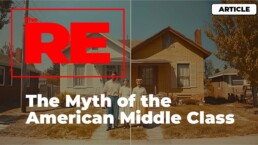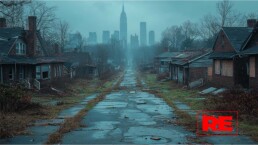The Myth of the American Middle Class
- Home
- News and Commentary
- The Myth of the American Middle Class
Share On Social

Today in The Ripple Effect, we are unpacking one of the most durable and dangerous stories in American life, the idea of a stable and thriving middle class. For decades, it has been treated as both a reward for hard work and a birthright of American citizenship. But underneath the slogans and the nostalgia, there is a harder truth. The middle class was never a guarantee. It was a temporary construction, a carefully engineered outcome of specific historical forces that have long since disappeared.
The Birth of a Temporary Dream
After World War II, the United States emerged as the only major industrial power untouched by the devastation of war. Europe and Asia were rebuilding from rubble while American factories boomed. Soldiers returned home to a government ready to invest in them through the GI Bill, offering cheap loans for education and housing. Wages were strong. Unions were powerful. Corporate profits were high but heavily taxed. The economy grew, and with it, so did the idea that a normal life included a home, a car, a vacation, and a pension.
But even during its peak, the American middle class was never universal. Redlining locked Black families out of homeownership. Women were pushed into unpaid domestic roles. Immigrants and minorities were often excluded from the most lucrative sectors. The system was tilted, but it was broad enough to create the illusion that prosperity was possible for most.
The Cracks Begin
By the 1970s, the pillars that supported the middle class started to crack. The oil crisis exposed America’s economic vulnerabilities. Inflation spiraled. Globalization meant factories could move where labor was cheaper. Deregulation under Presidents Carter and Reagan shifted power away from workers and toward corporations. Unions weakened. Real wages stagnated even as productivity kept climbing.
At the same time, something more invisible was happening. The rise of computers and networked information systems began to change what value even meant. Wealth was no longer just measured in products made or crops harvested. It started shifting into data, software, financial services, and intangible assets. The economy was digitizing, but the story of the middle class stayed frozen in a 1950s time capsule.
The New Economy and the New Divide
By the 1990s and early 2000s, the transformation was complete. Manufacturing was gutted. The biggest fortunes were built not on assembly lines but on platforms. Amazon, Google, Facebook, Apple, Microsoft, these companies did not produce goods in the traditional sense. They controlled information, access, and attention.
This mattered because wealth creation shifted away from broad-based employment toward highly concentrated tech monopolies. A handful of engineers, designers, and executives made fortunes. Gig workers and service employees fought for scraps. The old middle class pathways, the ones that ran through unionized factories, affordable education, and steady promotions, collapsed into unstable contracts, freelance gigs, and digital hustle culture.
Information became the new raw material. Platforms became the new factories. Algorithms became the new foremen, deciding who got seen, who got paid, and who got left behind.
Debt and Illusion
Even as these structural shifts hollowed out economic security, the cultural image of the middle class stayed alive through another tool, debt. Easy credit replaced rising wages. People bought homes they could not afford. They paid for college degrees with loans they could barely repay. They masked economic instability with mortgages, car payments, and endless monthly subscriptions.
The financial crisis of 2008 ripped the mask off for a while. Millions lost homes, jobs, and savings. But instead of building something different, the system rebooted with even more inequality baked in. Wall Street got bailed out. Tech platforms expanded. Workers got lectures about resilience and entrepreneurship.



The Role of Information Control
The new middle class myth is no longer just about material goods. It is about managing perception. Social media platforms reward curated lives. News outlets reinforce tribal identities. Political campaigns sell nostalgia packaged as hope.
Algorithms determine what you see, what you believe, and what you aspire to. The dream is still sold daily through Instagram filters, YouTube ads, and LinkedIn posts about personal branding. But it is hollow. A shrinking number of people control a growing share of wealth, influence, and opportunities. The rest are left chasing a promise that was never designed to be kept.
The Real Ripple Effect
When the middle class shrinks, democracy weakens. Economic stability is not just about comfort. It is about the ability to participate meaningfully in civic life. It is about time to vote, time to volunteer, time to think beyond survival.
When the middle class becomes a myth, trust erodes. People retreat into tribes. They seek scapegoats. They abandon institutions. They look for simple answers to complex problems, often at the cost of freedom and solidarity.
The Future We Are Building
The real question is not whether the middle class will come back. It will not, at least not in the old form. The real question is whether we are willing to stop chasing a ghost and start imagining new models of stability, dignity, and opportunity that match the realities of a digital, globalized economy.
Local economies, worker cooperatives, universal basic income experiments, platform cooperativism, these are not magic bullets. But they are attempts to grapple with a world where the old rules no longer apply.
Recognizing the myth is not defeat. It is a starting point. It is the first step toward building something real, something rooted not in nostalgia, but in reality.
